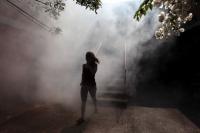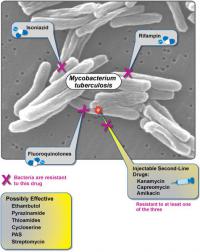-
The politicization of U.S. handling Ebola may carry over to Zika
If the United States responds to Zika the way it did to Ebola — and early indications are that in many ways it is — the country can expect missteps brought about by a lack of health care coordination and a lot of political finger pointing, according to a new analysis. The researchers studied the U.S. response to Ebola and found a fragmented system with no clear leadership, and considerable “strategic politicization” due to the outbreak’s arrival during a midterm election year.
-
-
U.S. needs greater preparation for next severe public health threats: Experts panel

In a report released last week by the U.S. Department of Health and Human Services (HHS), an Independent Panel formed to review HHS’s response to Ebola made several recommendations on how the nation’s federal public health system should strengthen its response to major public health threats, both internationally and domestically. “Without focused and sustained effort, the result of other novel public health threats could be much more devastating,” said the chairman of the Independent Panel.
-
-
Widespread outbreak of Zika virus in U.S. unlikely: Expert
An infectious disease expert says that Americans should not concerned about a widespread Zika virus outbreak in the United States. “The density of mosquitoes in the United States is not what it is in other countries,” says the expert, a member of the World Health Organization Emergency Committee on Zika virus. “In order to sustain an epidemic, a large population of mosquitoes that are close together with a dense population of people is needed for Zika virus to transmit more efficiently.”
-
-
Lessons of 1976 Ebola outbreak analysis are relevant today
With the recent Ebola epidemic in West Africa reviving interest in the first outbreak of the deadly hemorrhagic fever 40 years ago, scientists have released a report highlighting lessons learned from the smaller, more quickly contained 1976 outbreak. “Key to diagnosis in 1976 was the relatively quick clinical recognition of a severe, possibly new disease by national authorities,” according to one of the researchers.
-
-
Anthrax capsule vaccine completely protects monkeys from lethal inhalational anthrax
Vaccination with the anthrax capsule — a naturally occurring component of the bacterium that causes the disease — completely protected monkeys from lethal anthrax infection, according to a new study. These results indicate that anthrax capsule is a highly effective vaccine component that should be considered for incorporation in future generation anthrax vaccines.
-
-
"Flesh-eating" bacteria scares shouldn't keep you off Texas beaches
Every summer as millions flock to Gulf Coast beaches, another seasonal cycle begins: news stories of what we should fear. Most recently in Texas, there have been a number of stories about so-called flesh-eating bacteria infecting beachgoers, Vibrio vulnificus.. Sensationalized news about health threats like V. vulnificus undermine rational thought and distort perspective, but there is plenty of good information out there to make your own decision about risk. I hope to see you on the beach.
-
-
Integrating military, civilian trauma care systems could prevent up to 20% of U.S. trauma deaths
The leading cause of death for Americans under the age of 46 is trauma — a disabling or life-threatening physical injury that results from an event such as a motor vehicle crash, gun violence, or fall. In 2013, trauma cost approximately $670 billion in medical care expenses and lost productivity. Of the 147,790 U.S. trauma deaths in 2014, as many as 20 percent — or about 30,000 — may have been preventable after injury with optimal trauma care. Mass casualty incidents and increasing foreign and domestic threats to homeland security lend urgency to the translation of wartime lessons to civilian trauma systems, says a new report.
-
-
Zika threatens world's blood supply: Experts

Blood safety researchers say it is highly likely that the mosquito-borne Zika virus can be transmitted through blood transfusions and are calling for an evidence-based approach to protecting the blood supply from the threat of Zika virus.
-
-
Predicting contagiousness to help limit the spread of disease
Imagine the workplace during flu season. Some people get sick and display clear symptoms — a warning sign to coworkers to avoid contact and for that individual to stay home. Others are infected, but never or only belatedly exhibit the tell-tale signs of sickness, meaning they can infect coworkers without knowing it. If healthcare professionals had the ability to test in advance whether a person is likely to spread a disease following infection, they could recommend specific measures to treat the person or limit exposure and perhaps keep an outbreak from growing into an epidemic or pandemic. DARPA’s new Prometheus program is setting out to develop that predictive capability.
-
-
Electronic anti-theft systems pose a threat to cardiac device patients
Researchers say that electronic anti-theft systems still post a threat to cardiac device patients. Experts say that even though reported events are rare, prolonged exposure to electronic anti-theft systems, also called electronic article surveillance (EAS) systems, can cause pacing therapy to drop beats or in the worst case leave pacemaker dependent patients with no heartbeat, and cause ICDs to deliver inappropriate shocks.
-
-
Floridians uncomfortable with use of genetically modified mosquitoes to limit spread of disease
A small survey of residents of a Florida Keys neighborhood where officials hope to release genetically modified mosquitos to potentially reduce the threat of mosquito-borne illnesses such as Zika finds a lack of support for the control method.
-
-
New proposal seeks to focus on the fix for lead poisoning
The crisis of lead-contaminated drinking water in Flint, Michigan, continues to make headlines — but it is just the most prominent example of an “ongoing and needless tragedy of childhood lead poisoning,” says a leading expert on childhood lead poisoning prevention. The “debacle” in Flint should spur urgently needed but long-delayed action to address the continuing crisis of lead poisoning in the United States and around the world.
-
-
Zika virus expert: Tourists should “think twice” about going to Disney World
A leading public health expert has warned tourists to “think twice” about visiting parts of the United States, including Walt Disney World in Florida, because of the future threat of the Zika virus in the country. Pregnant women and couples looking to conceive should be particularly wary of going on holiday to southern states such as Florida, Texas, and Louisiana, he said.
-
-
Predicting the spread of the Zika virus

Countries that are well connected to Brazil have been at particularly high risk of importation of the Zika virus, according to researchers. However, subtropical and tropical countries with a history of dengue and other mosquito-borne diseases have the greatest risk of the virus spreading once it arrives in the country.
-
-
Pennsylvania superbug infection could mean "the end of the road" for antibiotics: Researchers

Researchers have, for the first time, found a person in the United States carrying a bacteria resistant to antibiotics of last resort. Top U.S. public health officials say this is alarming, and could mean “the end of the road” for antibiotics. Researchers say that the discovery “heralds the emergence of a truly pan-drug resistant bacteria.”
-
More headlines
The long view
We Ran the C.D.C.: Kennedy Is Endangering Every American’s Health
Nine former leaders of the Centers for Disease Control and Prevention (CDC), who served as directors or acting directors under Republican and Democratic administrations, serving under presidents from Jimmy Carter to Donald Trrump, argue that HHS Secretary Roert F. Kennedy Jr. poses a clear and present danger to the health of Americans. He has placed anti-vaxxers and conspiracy theorists at top HHS positions, and he appears to be guided by a hostility to science and a belief in bizarre, unscientific approaches to public health.
